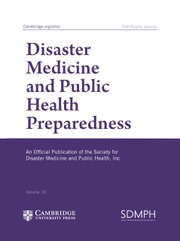No CrossRef data available.
Article contents
Experiences of Communities Living in Shelters During the 2022 Eastern Kentucky Floods
Published online by Cambridge University Press: 10 December 2024
Abstract
On July 28, 2022, floods in eastern Kentucky displaced over 600 individuals. With the goal of understanding mental health needs of affected families, we surveyed households living in flood evacuation shelters after the 2022 Kentucky floods.
Families experiencing displacement from the 2022 Kentucky floods currently living in three different temporary shelter locations were surveyed via convenience sampling. A rapid community needs assessment involving in-person interviews using modified two stage cluster methodology (CASPER) was conducted between September 6-9, 2022.
Teams conducted 61 household interviews. Since the flood, 27.7% reported that their household received services from behavioral health and 19.6% received grief counseling. Experiencing agitation (36.7%), difficulty concentrating (47.5%), nightmares (62.3%), or suicidal thoughts/self-harm (6.6%) were reported by households surveyed. Over one-fourth (27.0%) of individuals surveyed reported being depressed nearly every day. Over 20% reported anhedonia (inability to feel pleasure) nearly every day. Over 75% of individuals surveyed reported being anxious several days or more over the last two weeks. Over one-third of individuals (34.0%) reported being unable to stop worrying nearly every day. Of those individuals surveyed, 36.1% reported barriers to mental health services.
Symptoms of depressed mood, anhedonia, anxiety, and nightmares were prevalent in displaced families six weeks after the 2022 Kentucky floods. Providing and encouraging access to mental health services are important priorities during disaster recovery.
Keywords
- Type
- Original Research
- Information
- Copyright
- © The Author(s), 2024. Published by Cambridge University Press on behalf of Society for Disaster Medicine and Public Health, Inc


